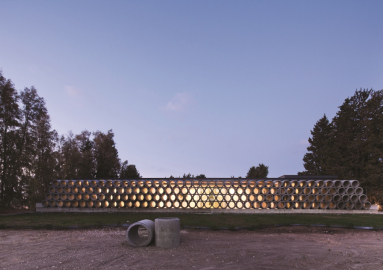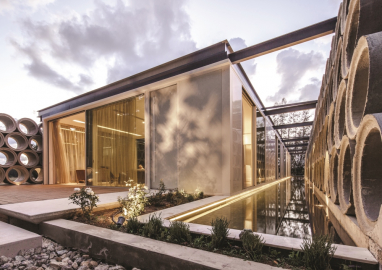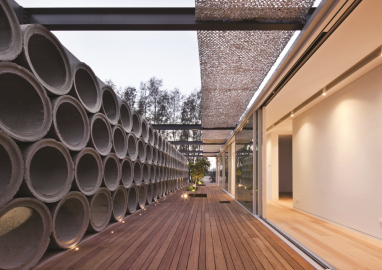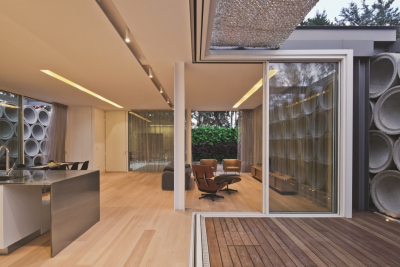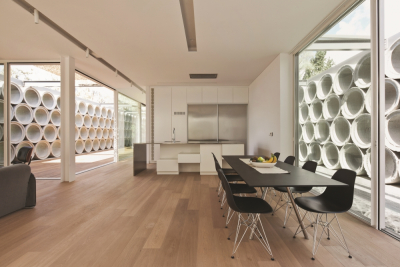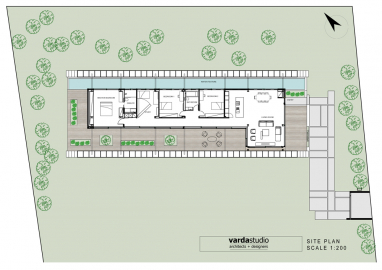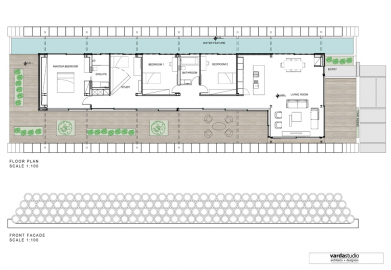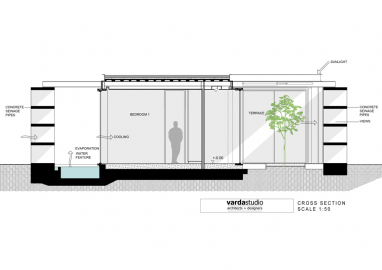House A&B
A&B House is the architects' own residence.
A metal-framed 4-bedroom residence in an agricultural plot, it is flanked by two walls of concrete pipe sections. The project uses an integrated Envelope system for the external walls and glazing, in conjunction with steel framing.
The layout is linear along the east-west axis. The open plan living area is to the east, providing a dining area, kitchen, and sitting area. Three bedrooms and a study are placed along a corridor-gallery that runs the length of the house. Huge glass doors slide open to the deck veranda that runs outside to the south. The veranda is dispersed with garden pockets, containing small trees and fragrant plants.
To the North is a water corridor that abuts the house. The same large sliding doors open directly to it. The water corridor sets the ambience of the soundscape and influences the light, reflecting it to the interior.
The concept was born of the combination of two materials often found near this location: concrete tube pipe sections and metal sheet. The materials are translated here to the residence’s two separate envelopes: a metal structure clad in metal and glass, and the two walls of stacked concrete pipe sections running along the north and south facades of the residence.
The site is an agricultural field in Koloni. To the north is the only neighbour, another residence. To the east is a public road, with a row of mature pines forming the boundary. The plot is generally level and exposed to views from the public roads to the south and west. Access to the site is from the road to the east.
The residence is placed to the north part of the plot along an east-west axis, orienting its long façade towards the south whilst freeing up the southern-most part of the land for a deck, lawn, and gardens beyond.
The interior benefits from a high degree of thermal insulation thanks to the Envelop system. In the winter the south façade enjoys passive solar gains. An awning above the glass provide shade in the summer and prevent overheating, whilst the concrete tube walls shelter from strong winds.
The first envelope comprises the load-bearing metal structure sitting on a concrete slab foundation. The roof is formed of corrugated metal sheet, and the exterior walls are formed of aluminium-framed double glazing, fixed and moving, part of an integrated system, Envelop 3D. The glass envelope provides unobstructed views to the outside. Clean, minimal, and technologically advanced, it creates a strong contrast with the second envelope.
The second envelope of concrete tubes is heavy, earthy, low-tech. It provides additional sheltering from the environment, specifically the sun and air, and filters views from and towards the house.
The Envelop 3D system used here is an integrated system with modules for different functions: fixed external walls, sliding and fixed windows, entrance door. It is installed in a single continuous track, 76 metres long.
The walls contain polystyrene and fiberglass thermal insulation and are sealed externally with white glass. The internal surface is a double layer of plasterboard. The sliding doors are designed to lock in an open position, small enough to be secure, whilst allowing natural ventilation to all spaces.

